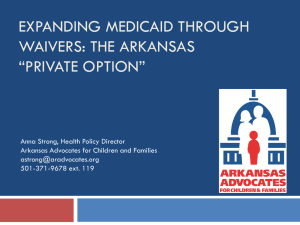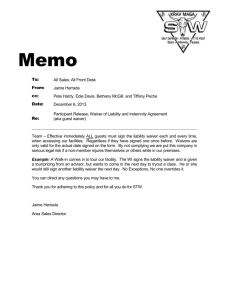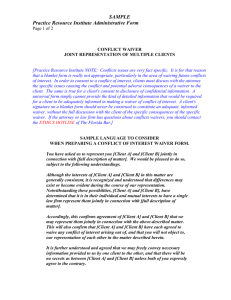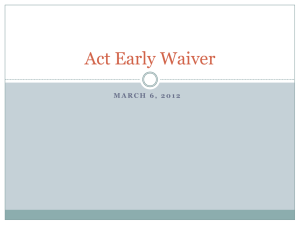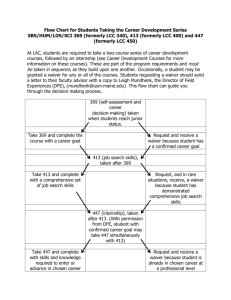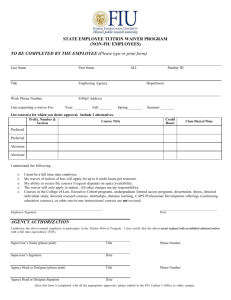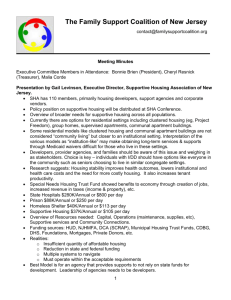What the Community Care Waiver Means for Your Family Member:
advertisement
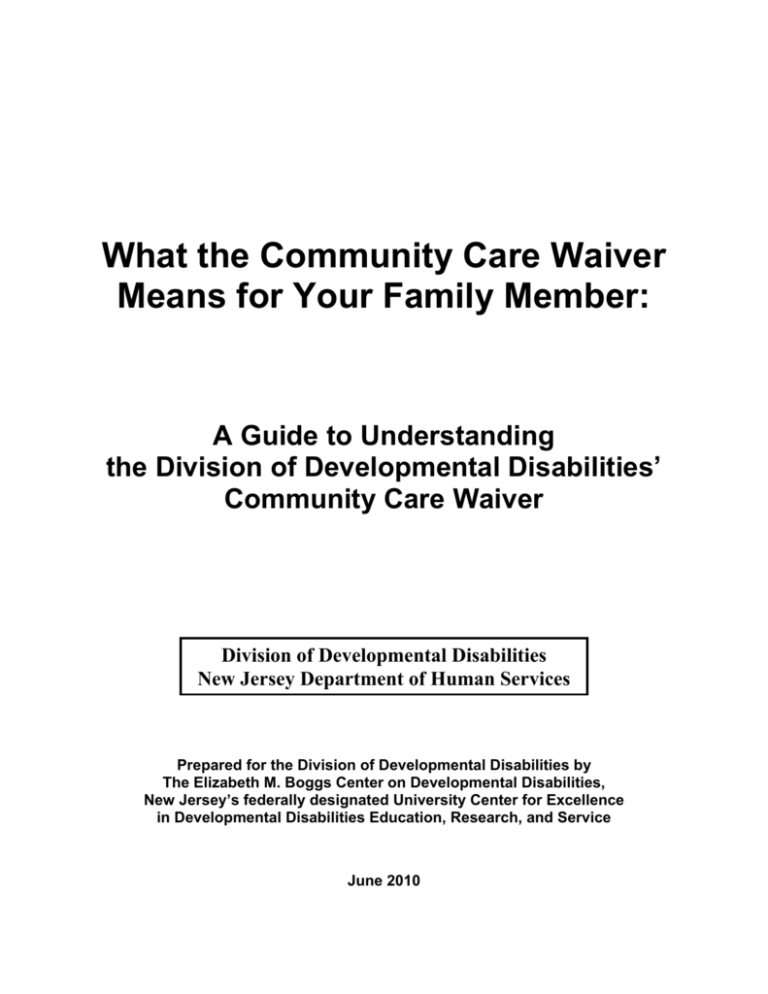
What the Community Care Waiver Means for Your Family Member: A Guide to Understanding the Division of Developmental Disabilities’ Community Care Waiver Division of Developmental Disabilities New Jersey Department of Human Services Prepared for the Division of Developmental Disabilities by The Elizabeth M. Boggs Center on Developmental Disabilities, New Jersey’s federally designated University Center for Excellence in Developmental Disabilities Education, Research, and Service June 2010 Part 1 Understanding Waivers Why does it matter that I know about the Division of Developmental Disabilities’ Community Care Waiver? New Jersey’s Division of Developmental Disabilities (DDD) pays for many of its community-based services through its Community Care Waiver. Understanding how the Community Care Waiver fits into the services DDD provides, what the waiver can (and can’t) pay for, what the process is for getting onto the waiver, and what it means to be on the Waiting List for Services are all critically important pieces of information to have when planning for your family member’s care. Without that understanding, an already complicated system can become much more confusing and difficult to navigate. How does the Community Care Waiver fit into the services DDD provides? DDD recognizes that the kinds of services and supports that individuals with developmental disabilities and their families want are changing. Expectations for living a full life in the community have grown, and with those changing expectations has come the need to find new ways of providing services. With this in mind, DDD is broadening its focus beyond that of simply providing “residential placements” to thinking about how to help individuals create lives that are right for them, whether they continue living with their families or transition to a living arrangement outside the family home. In other words, DDD is moving away from simply asking, “Where do you need to live?” and instead is asking, “What services do you need, regardless of where you live?” How does DDD know what services someone needs? Once individuals are enrolled on the waiver, their needs are assessed and the waiver services they receive are based on that assessed level of need. Why are they called Medicaid waivers? Before we can talk in more detail about DDD’s waiver, it’s important to briefly explain what Medicaid is. Medicaid is a federal/state partnership that provides government funded health insurance to individuals with low incomes, including individuals with disabilities. The types of medical services paid for by Medicaid are sometimes called “acute care medical services.” What the Community Care Waiver Means for Your Family Member June 2010 1 Based on an individual's needs, Medicaid can also provide government funding for long term services and supports. These are services that individuals with chronic health conditions or disabilities need, in addition to acute care medical services. Long term services and supports can include services such as individual supports, day programs, case management, and supported employment. Eligibility for Medicaid depends on an assessment of an individual’s disability, as well as his or her income and resources. What exactly is a “waiver?” Historically, Medicaid has funded long-term care that was provided mostly in nursing homes and large institutions. In 1981, a new section of the Social Security Act was signed into law that established the Medicaid Home and Community-Based Services waivers, often referred to as HCBS or 1915 waivers. These waivers permit states to use Medicaid funding to provide long-term care in the community. Waivers are intended to help individuals avoid institutionalization by remaining in, or returning to, the community. Waivers are designed to meet certain specific needs, and provide different benefits than the traditional Medicaid program. They are called “waivers” because some of the rules that apply to Medicaid are being waived, or set aside. Since 1982, New Jersey’s Division of Developmental Disabilities has administered a Home and Community Based Services (HCBS) waiver which is commonly called the "Community Care Waiver” or the “CCW.” What services does the waiver pay for? For an individual enrolled on the waiver, services may include: • Case Management • Individual Supports (in a residential facility or in a person’s home) • Day Habilitation Services • Respite Care • Supported Employment Services • Transition Services • Support Coordination (for individuals who self-direct their services) • Assistive Technology Devices • Environmental and Vehicle Adaptations • Personal Emergency Response Systems (PERS) • Transportation Services Specific services that are available to an individual depend on his or her assessed level of need. Services will be paid for up to the amount or extent permitted under the waiver. 2 What the Community Care Waiver Means for Your Family Member June 2010 What doesn’t the waiver pay for? The waiver does not pay for: • • • • Food Housing Vacations Direct support workers/providers who are not approved Medicaid providers. To be Medicaid approved, a provider must complete the application process and criminal background check. There are also approved rates and levels of funding for particular services (for example, specific hourly rates for respite services). The waiver will not pay for rates and expenses that go above those levels. Does the waiver help with medical needs? Individuals who are enrolled on the waiver also receive a Medicaid card which provides coverage for acute care medical services such as doctors’ visits, hospitalizations, and prescription drugs. What is an “individual budget?” An “individual budget” is the amount of money designated by DDD to provide services for an individual at his or her assessed level of need. Individuals can choose to receive their services through something called the “self-directed option.” The self-directed option means individuals and their families take the lead in finding and obtaining the services they want and need. Individuals also can choose something called the “provider-managed option,” which means they choose a provider to manage their services and supports. For both of these options, the budget is based on the individual’s assessed level of need. Decisions about which services to obtain through the budget are based on the individual’s plan of care. Individuals who do not need to spend their entire budget in a particular year cannot save those monies to spend in the next year. However, in the next year, as long as their assessed level of need remains the same, their level of funding also will remain the same. Is there a waiting list for DDD’s Community Care Waiver (CCW)? Yes. Waivers are written to serve a certain number of individuals, based on the amount of funding set by the Governor and New Jersey Legislature. Currently more people are in need of services than the CCW is able to fund. What the Community Care Waiver Means for Your Family Member June 2010 3 DDD has changed the focus of its waiting list. What used to be called the “Residential Waiting List” is now called the “Waiting List for Services” (sometimes referred to as the “WLS”). This change is a result of DDD’s shift from providing “residential placements” to providing the services individuals need, no matter where they live. The Waiting List for Services includes three categories: Priority, Priority Deferred, and General. The “Priority Residential Waiting List” has been renamed the “Priority Category of the Waiting List for Services,” with all individuals remaining on the list with their original date of application. The “Priority Deferred Residential Waiting List” has been renamed the “Priority Deferred Category of the Waiting List for Services,” with all individuals remaining on the list with their original date of application. The “General Residential Waiting List” has been renamed the “General Category of the Waiting List for Services,” with all individuals remaining on the list with their original date of application. Whether or not they are on the General Category of the Waiting List, individuals, or their parent or guardian, must notify DDD when both parents or guardians turn 55 years old, and specifically ask to be put on the Priority Category of the Waiting List for Services. Individuals on the waiting list will be served in chronological order, based on the date they were added to the list. DDD will notify individuals when their name comes to the top of the list and state funding becomes available. At that point, DDD will assist individuals with applying for Medicaid (if they’re not already receiving Medicaid) so that they can be enrolled on the waiver. 4 What the Community Care Waiver Means for Your Family Member June 2010 Part 2 What does the Community Care Waiver mean for my family member? What are the specific steps for getting services through the Community Care Waiver? The following is what needs to happen for someone to receive services through the Community Care Waiver (CCW): • Individuals must apply to DDD and be determined eligible to receive DDD services. • In order to receive waiver services through DDD, it is very important that individuals, or their parent or guardian, ask DDD to add the individual to the Waiting List for Services. This can be done when an individual is determined eligible for DDD services, or at any time after that. Individuals whose parents or guardians are under age 55 will be added to the General Category of the Waiting List for Services. Individuals whose parents or guardians are age 55 or over will be added to the Priority Category of the Waiting List for Services. Remember, individuals, or their parent or guardian, must specifically ask that the individual be added to the Priority Category of the Waiting List for Services when the parents or guardians turn 55. • DDD will notify individuals annually of their place on the Priority Category of the Waiting List for Services. • DDD will notify individuals at the top of the Priority Category of the Waiting List for Services when state funding becomes available to pay for waiver services. • When individuals come to the top of the Priority Category of the Waiting List for Services, they will be asked to apply for Supplemental Security Income (SSI), if they haven’t already done so. SSI is a federal benefit for individuals with disabilities provided through the Social Security Act. In New Jersey, SSI also provides eligibility for Medicaid. DDD can assist individuals with the SSI application process. • Once individuals are found eligible for Medicaid, DDD will take care of enrolling them on the waiver. • As part of the waiver enrollment process, individuals will be assessed for their level of need for the purposes of developing an individual budget. • A plan of care will then be developed based on an individual’s needs and individual budget. What the Community Care Waiver Means for Your Family Member June 2010 5 How will my family member’s needs be assessed? An assessment tool will be used to look at an individual’s functional, behavioral, and medical needs. For family members who want to focus on their family member’s strengths, this part of the process can sometimes feel difficult. It is important to remember that the purpose of the assessment is to determine a budget level that will provide for the necessary services and supports for the individual. Be sure to take into account any supports you provide to help your family member complete tasks and activities successfully. Supervision, reminders, prompts, helping your family member re-do a task, helping with part of a task, hand-on-hand assistance, or doing the entire task yourself are all supports you may be providing as you care for your family member. How will my family member’s Plan of Care be developed? An Individual Plan of Care (POC) is developed once an individual is enrolled on the waiver, his or her needs have been assessed, and a budget level is assigned. The Individual Plan of Care, which includes an Essential Lifestyle Plan (ELP), identifies the specific services someone needs. What if I feel that my family member needs something that isn’t paid for by the waiver? Unfortunately, DDD does not have enough funds to provide everyone with all the individualized supports they may request. Individual budgets are limited and so individuals must prioritize what they need to fit within those budgetary limits. Given that reality, individuals are encouraged to find resources outside of DDD. Your family member’s case manager or support coordinator (if your family member is self-directing his or her services) will assist you with finding other resources. What happens when the needs of my family member changes? It’s possible that someone’s assessed level of need will change. This, in turn, could increase the individual’s funding level so that he or she is able to get more waiver services within the home. The assessment could also lead to a decision that the needs of the individual and family are such that the services can best be provided in a placement outside the family home. What if my family member applies but is not found eligible for Medicaid? DDD asks that everyone apply for Medicaid. However, if they apply and are not found eligible, they will not be enrolled on the waiver but their services will be paid for by state-only (i.e., non-Medicaid) dollars. If someone refuses to apply for Medicaid, then DDD will limit the amount paid for services to the amount of state funds available. 6 What the Community Care Waiver Means for Your Family Member June 2010 How do I know where my family member is on the Waiting List? Your family member’s position on the Priority Category of the Waiting List for Services is based on his or her date of application for the Priority Category of the Waiting List for Services. Every year DDD will send out letters letting each individual know his or her number on the Priority Category of the Waiting List for Services. Unfortunately, having a number doesn’t necessarily tell you how long the wait is. That depends on a number of factors, including whether or not additional funding has been allocated in the state budget to fund new waiver openings. What happens while my family member is waiting to be enrolled on the waiver? DDD may provide some services that are paid for by non-Medicaid money (often referred to as “stateonly funds”). Family Support is currently one such program. It provides services such as respite for families caring at home for their family member with a disability. Day services for young adults transitioning out of the education system can also be funded through state-only dollars. DDD has been committed to ensuring that everyone who is eligible for DDD has a day service available to them, once they turn 21 and their educational entitlement has ended. You also can call the New Jersey Division of Disability Services (DDS), which is New Jersey’s information and referral center for disability-related resources. DDS’ Information and Referral Specialists can help connect people with a range of services. DDS can be reached at 1-888-2853036, TDD 609-292-1210. What about an emergency? When an emergency arises, DDD will provide assistance, if necessary, with state-only funds, and will help arrange whatever supports will keep the individual safe. Services to help keep the individual safely in his or her home will be considered before an emergency out-of-home residential placement is made. What if we’re not sure what would be best for our family member? There are many factors to consider when planning for the future. There are an individual’s needs and desires, as well as the needs of the family, and there are the realities of the community where they live. For example, do they live in a rural or urban area? Do they live near extended family? Person-centered planning is a process for thinking about the future that takes all of this into account, and helps families arrive at a plan that makes sense for everyone involved. For information about training opportunities for person-centered thinking, go to New Jersey’s training calendar: http://www.fscnj.org/content/trainings/calendar/view.php, or contact The Family Support Center of New Jersey at 1-800-372-6510. What the Community Care Waiver Means for Your Family Member June 2010 7 Tips for thinking about the future: My family member will be graduating from high school in a couple of years. What should I do? • At age 14, make sure your school district includes transition planning as part of your family member’s Individualized Education Program (IEP). When developing a transition plan, it’s important to understand that your family member will not be able to participate in day services funded by DDD until his or her educational entitlement ends at age 21. • Call DDD to make sure your family member has been found eligible for services funded by DDD. If not, ask for an application. • Assuming state funds are available, your family member should have day services in place when his or her educational entitlement is completed. (It is not necessary to be Medicaid eligible in order to receive day services.) • The Family Support Center of New Jersey offers transition planning workshops. For information about these workshops, contact the Family Support Center at http://www.fscnj.org/ or 1-800-372-6510 • At age 18, make sure that your family member applies for Supplemental Security Income (SSI). My family member was on what had been called the Priority Residential Waiting List. What do I do? • There is nothing you need to do. Your family member will continue to be enrolled on the waiting list, which is now called the Priority Category of the Waiting List for Services. My family member was on what had been called the General Residential Waiting List. What do I do? 8 • There is nothing you need to do Your family member will continue to be enrolled on the waiting list, which is now called the General Category of the Waiting List for Services. • Notify DDD when both parents or guardians turn 55 and ask that your family member be added to the Priority Category of the Waiting List for Services. What the Community Care Waiver Means for Your Family Member June 2010 My family member is an adult but is not on any Residential Waiting List. What do I do? • Contact DDD immediately and ask that your family member be added to either the General Category of the Waiting List for Services or, if both parents or guardians are over age 55, to the Priority Category of the Waiting List for Services. My family member is living at home and is receiving services through the waiver. However, I am having problems with my own health and need to help my family member find a new place to live. What do I do? • Call your family member’s DDD case manager or Support Coordinator (if your family member has been self-directing his or her services) to explain that your ability to provide care has significantly changed, and that your family member’s situation needs to be re-assessed. Once your family member’s assessed level of need has changed, his or her funding level may change so that more waiver services or provided within the home. If, even with additional funding, continuing to provide care at home is no longer possible, DDD will work with you to identify other residential options for your family member. What the Community Care Waiver Means for Your Family Member June 2010 9
